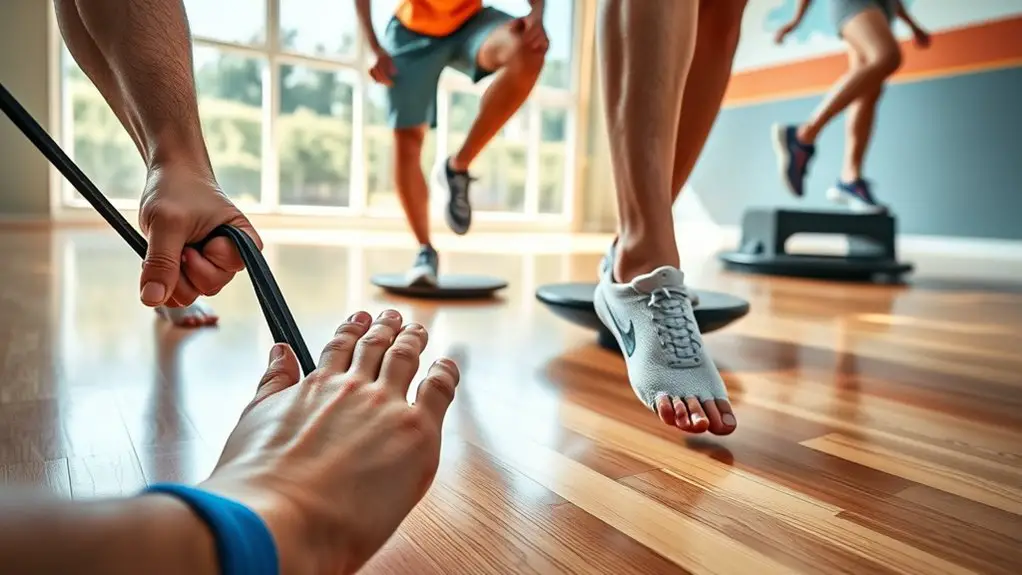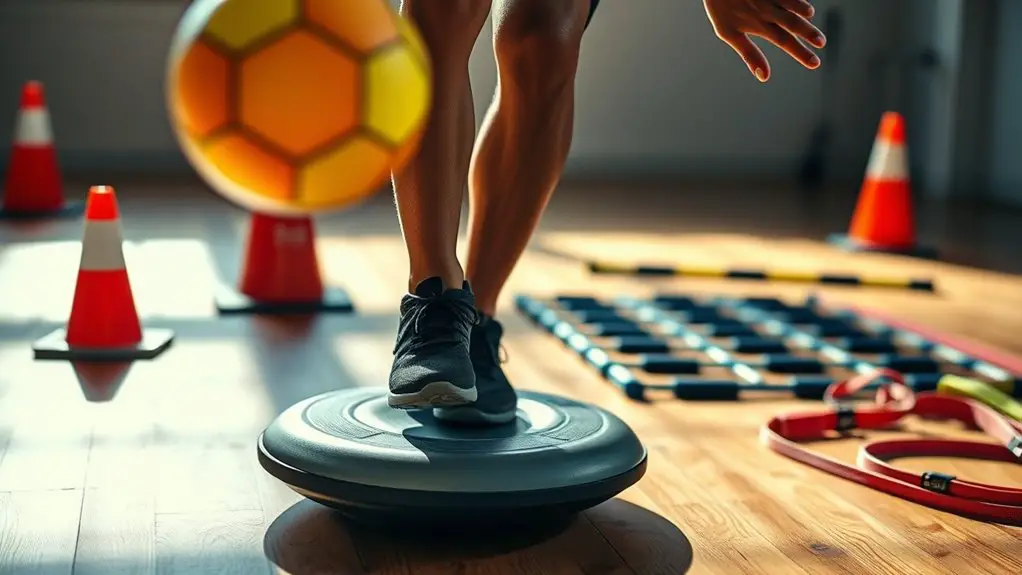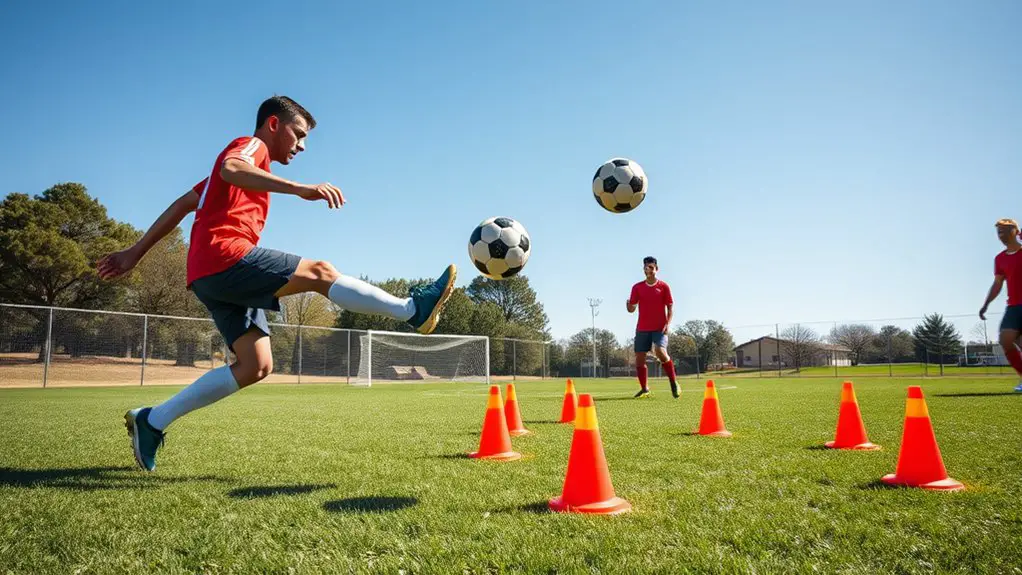To enhance your foot health as an athlete, focus on a mix of exercises. Start with toe raises to strengthen your feet and heel walks to improve stability. Incorporate arch strengthening with foot domes and calf stretches for flexibility. Balance exercises on one foot will boost your coordination. Don't forget resistance band workouts to activate foot muscles. Finally, implement cool down techniques to guarantee proper recovery. There's even more to explore for optimizing your foot fitness.
Importance of Foot Health for Athletes
Foot health is essential for athletes, as it serves as the foundation for overall performance. If you want to release your full potential, you can't overlook foot injury prevention. Your feet endure a lot of stress during training and competition, so keeping them in top shape is vital. One of the first steps in safeguarding your feet is making the right footwear selection. Choose shoes that not only fit well but also provide the necessary support and cushioning for your specific sport. Proper footwear can greatly reduce the risk of injuries like sprains or stress fractures, allowing you to train and compete with confidence. Remember, when your feet feel good, you're free to move, jump, and run without hesitation. Prioritizing foot health isn't just about comfort; it's about empowering your performance and enjoying the freedom to excel in your athletic journey. Selecting the right type of cleats for your sport can greatly enhance your performance and reduce the risk of injury.
Warm-Up Exercises for Your Feet
Before you hit the field or court, warming up your feet can make a significant difference in your performance and injury prevention. Start with some dynamic stretching to get the blood flowing. Simple movements like ankle circles and toe taps can really enhance your foot mobility and flexibility. You'll feel the difference as you prepare to release your potential.
Incorporate mobility drills, such as heel-to-toe walks and foot rolls, to activate those vital muscles and joints. These exercises not only improve your range of motion but also help in preventing common foot injuries. You want your feet to feel light and responsive, ready for whatever challenges come your way. Proper footwork is essential for injury prevention and effective gameplay, ensuring you can perform at your best.
Don't skip this vital step in your routine. A few minutes of focused warm-up exercises will have your feet primed for action, allowing you the freedom to play your best game without worry. Your feet deserve this attention!
Toe Raises for Strengthening
While it might seem simple, toe raises are an effective exercise for strengthening the muscles in your feet and lower legs. By incorporating toe raise variations, like single-leg raises or raised toe holds, you can target different muscle groups, enhancing your overall stability and power. These exercises not only improve your strength but also help prevent injuries, ensuring you maintain your freedom to move effortlessly.
The toe raise benefits extend beyond just muscle strengthening; they also promote better balance and coordination, essential for any athlete. You can easily perform these exercises anywhere—whether at home, the gym, or even during breaks. Just stand tall, lift your toes while keeping your heels on the ground, and feel the burn! Remember, consistency is key. So, make toe raises a regular part of your routine, and release the potential in your feet for all your athletic endeavors.
Heel Walks for Improved Stability
Heel walks are a fantastic way to boost your stability and balance. By focusing on proper technique, you can maximize the benefits of this simple exercise. Let's explore how to incorporate heel walks into your routine effectively.
Benefits of Heel Walks
If you're looking to enhance your stability during athletic performance, incorporating heel walks into your routine can be incredibly beneficial. Not only do they strengthen your lower legs, but they also improve your balance and coordination. Here are some key heel walk benefits:
- Strengthens Ankle Stability: Heel walks can help prevent injuries by reinforcing the muscles around your ankles.
- Improves Posture: By engaging your core while walking on your heels, you promote better alignment.
- Versatile Variations: You can explore different heel walk variations, like toe-to-heel or lateral walks, to keep your workouts fresh.
Proper Technique Explained
To effectively perform heel walks and maximize their stability benefits, it's essential to focus on your form. Start by standing tall, engaging your core, and lifting your toes off the ground. As you walk, keep your heels firmly planted, allowing your foot biomechanics to work in harmony. Take smooth, controlled steps, ensuring your body remains aligned and balanced. This exercise isn't just about movement; it's about enhancing your stability and strengthening the muscles that support your ankles and feet. By practicing heel walks with proper technique, you'll promote injury prevention and improve overall performance. Remember, freedom in your movements comes from a solid foundation, so pay attention to how you engage your feet with every step.
Incorporating Into Routine
Incorporating heel walks into your routine can greatly enhance your stability, particularly if you're an athlete looking to strengthen your lower body. By adding this simple yet effective exercise to your foot routine, you can enjoy improved performance and reduced injury risks. Here's how to make heel walks a part of your daily exercises:
- Start with short distances, gradually increasing as you get comfortable.
- Focus on maintaining an upright posture to engage your core.
- Incorporate heel walks into your warm-up or cool-down sessions for maximum benefits.
Arch Strengthening With Foot Domes
When it comes to foot health, strong arches play an essential role in your overall athletic performance. You can effectively strengthen your arches with foot domes, which are simple yet powerful tools. By incorporating these exercises into your daily routine, you'll enhance your support and stability on the field.
Importance of Arch Support
While many athletes focus on strength and conditioning, the importance of arch support often gets overlooked. Proper arch support is essential for enhancing performance and preventing injuries, regardless of your arch types. Here are some key arch support benefits to take into account:
- Improved Stability: A strong arch helps maintain balance and reduces the risk of ankle sprains.
- Increased Efficiency: With proper support, your energy is better utilized, allowing for longer workouts without fatigue.
- Pain Reduction: Good arch support can alleviate discomfort in the feet, knees, and lower back.
Effective Foot Dome Techniques
One of the most effective ways to strengthen your arches is through foot dome techniques. These exercises not only enhance your foot's stability but also offer significant foot dome benefits, like improved balance and reduced injury risk. To start, try the classic toe curls; simply gather a towel with your toes while keeping your heel planted. For foot dome variations, you can also practice heel raises or single-leg balances, which engage different muscle groups and challenge your stability. Incorporating these techniques into your routine can lead to stronger arches, allowing you to enjoy your athletic pursuits without restriction. Embrace the freedom that comes from a well-supported foot, and watch your performance soar!
Incorporating Foot Domes Daily
Incorporating foot domes into your daily routine can markedly enhance your arch strength and overall foot health. These simple yet effective tools provide essential support during your daily foot exercises, leading to significant foot dome benefits.
To get started, try these quick and engaging exercises:
- Balance on One Foot: Stand on a foot dome to improve your stability and strengthen your arches.
- Toe Curls: Place a foot dome on the ground and curl your toes around it, helping to strengthen the muscles in your feet.
- Roll It Out: Use the dome to massage your feet, relieving tension and improving flexibility.
With consistent practice, you'll notice better strength and resilience in your arches, allowing you to move freely and confidently in your athletic pursuits.
Calf Stretching for Flexibility
Calf stretching is essential for athletes looking to enhance flexibility and prevent injuries. By focusing on your calf muscles, you'll access a world of flexibility benefits that can improve your performance in various sports. A well-stretched calf muscle allows for better range of motion, which means you'll move more freely and efficiently. Incorporating proper warm-up techniques into your routine can further enhance your injury prevention efforts.
To get started, try a simple wall stretch. Stand facing a wall, place your hands on it, and step back with one foot, keeping it straight. Bend your front knee and lean into the wall, feeling the stretch in your back calf. Hold for 15-30 seconds and switch legs. Another great option is the seated calf stretch, where you sit with one leg extended and use a towel to pull your toes towards you, deepening the stretch.
Incorporate these stretches into your routine, and watch your flexibility soar, keeping those injuries at bay.
Balance Exercises on One Foot
Balance exercises on one foot are essential for athletes aiming to improve stability and coordination. These exercises challenge your balance and enhance single leg stability, which is vital for peak performance. Here are three effective balance challenges you can try:
- Single Leg Stand: Hold one foot up for 30 seconds while focusing on a fixed point. Switch legs.
- Single Leg Deadlift: With a slight bend in your standing knee, hinge at the hips, lowering your torso while extending the opposite leg behind you. Return to standing.
- Tightrope Walk: Imagine a line on the floor; walk heel to toe in a straight line, focusing on maintaining your balance.
Incorporating these exercises into your routine not only strengthens your feet but also boosts your overall athleticism. Additionally, strong core muscles help prevent injuries, ensuring you can safely embrace these challenges, and you'll feel the difference in your performance!
Resistance Band Workouts for Foot Muscles
When you're looking to strengthen your foot muscles, resistance band workouts can be incredibly effective. These exercises not only promote foot muscle activation but also enhance stability and flexibility, giving you the freedom to move with confidence.
Start with simple resistance band exercises like toe flexion and extension. Secure one end of the band to a sturdy object and loop the other around your toes. As you flex and point your foot against the band's resistance, you'll target those essential muscles.
You can also try lateral band walks, which engage the muscles around your ankles and improve your overall foot strength. Just place the band around your ankles and take small steps side to side.
Incorporating these resistance band workouts into your routine will help you build a solid foundation, letting you run, jump, and play without limitations. Embrace the freedom that comes with strong, resilient feet! Additionally, these exercises aid in injury prevention and rehabilitation, allowing you to strengthen your foot muscles while minimizing the risk of injury.
Cool Down and Recovery Techniques for Feet
To guarantee your feet recover properly after intense workouts, incorporating cool down and recovery techniques is essential. Ignoring this vital step can lead to soreness and injuries, keeping you from the freedom you crave in your athletic pursuits. Here are a few techniques you should try:
- Ice baths: Soaking your feet in ice-cold water helps reduce inflammation and speeds up recovery.
- Foam rolling: Gently rolling your feet on a foam roller can relieve muscle tightness and improve blood flow.
- Stretching: Simple foot and calf stretches can enhance flexibility and prevent cramping. Additionally, incorporating hydration post-workout is crucial for replenishing lost fluids and supporting muscle repair.
Frequently Asked Questions
How Often Should Athletes Perform Foot Exercises?
When it comes to foot exercises, you might wonder how often you should be doing them. Frequency recommendations typically suggest incorporating foot exercises into your routine two to three times a week. This can easily fit into your workout schedules without feeling too restrictive. You'll find that consistent practice not only strengthens your feet but also enhances your overall performance, giving you the freedom to move more efficiently and enjoy your activities even more.
Can Foot Exercises Prevent Injuries in Athletes?
Imagine your feet as the sturdy roots of a mighty tree, grounding you and keeping you upright. Foot exercises can indeed be your shield against injuries, enhancing foot strength and stability. When you strengthen those roots, you're not just preventing injuries; you're embracing the freedom to move without fear. So, make those exercises a regular part of your routine, and watch as your body flourishes, ready to take on any challenge that comes your way.
What Are the Signs of Weak Foot Muscles?
If you're wondering about the signs of weak foot muscles, you might notice some telltale signs of dysfunction. You could feel pain or discomfort while walking or running, or maybe you're experiencing instability when standing. Excessive fatigue in your feet after activity can signal foot muscle weakness too. If you find it hard to maintain balance or coordination, it's time to pay attention and consider strengthening those muscles for greater freedom of movement.
Are There Specific Exercises for Different Sports?
Absolutely, there are sport-specific drills designed to boost foot strength. Depending on your sport, you might focus on agility drills for basketball or balance exercises for soccer. Incorporating these targeted exercises helps enhance your performance and reduces injury risk. It's all about finding what works best for you, so don't hesitate to mix things up and keep your routine fresh. Your feet will thank you as you gain that extra edge in your game!
Should Athletes Consult a Professional for Foot Issues?
Just like a car needs regular maintenance to run smoothly, your feet require proper care for peak performance. If you're experiencing foot issues, consulting a professional for advice is essential. They can help you understand your foot health better, ensuring you stay in the game longer. Ignoring problems can lead to bigger issues down the road, so don't hesitate to seek out expert guidance when you need it. Your freedom to move depends on it!




